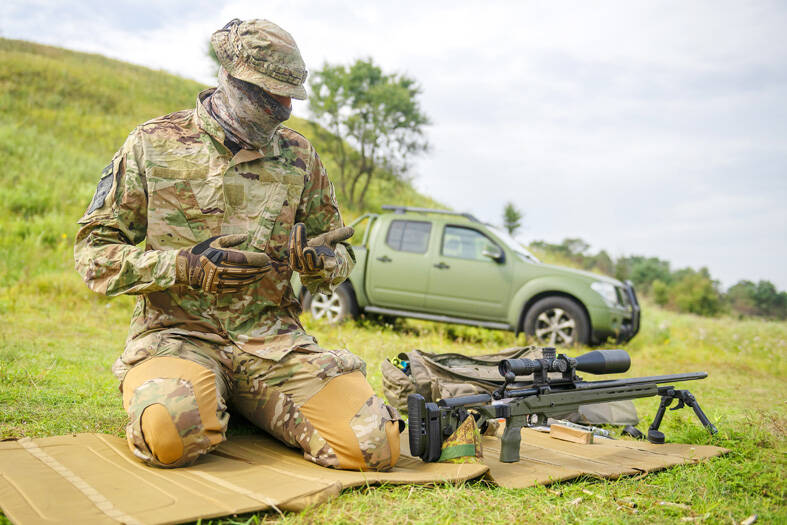Before taking a shot, Ukrainian sniper Andriy buries his face in a foldout mat, breathing slowly and deliberately.
“I need to be completely relaxed, to find a place where I will not move the rifle when I pull the trigger,” he said. “I don’t think about anything. It’s a kind of vacuum.”
In a semicircle around his head are boxes of bullets, printouts of charts, a heavy-duty stapler and a roll of tape. Strapped to his wrist is a monitor, which is the shape of a jewelry box. It is a ballistics calculator to factor in the wind and other surrounding conditions. Bees persistently circling his head and scope are ignored. After a long pause, he says the word “shot” in Ukrainian.

Photo: AP
The sound of the discharge produces a reflexive jolt in people unaccustomed to war.
Six months ago, the noise might have startled Andriy, who had moved to western Europe to pursue a career in engineering. His experience resembles that of many Ukrainians who returned home to the war, abruptly pulled from civilian life to embrace fighting methods — modern, but also makeshift — that have contested the Russian military.
Andriy is from Bucha, a district near Kyiv’s airport that was hammered during the Russian advance.
Hundreds of civilian killings took place there, the bodies found in mass graves or left lying where they were shot in what the UN described as potential war crimes.
Tall and with a good command of English, the sniper spoke to reporters while practicing alone at an informal firing range near Kyiv, hoping to resolve some issues with his weapon through hours of trial and error before his next deployment.
He asked only to be identified by his first name and that some details of his civilian life remain private.
Andriy scrambled home, taking a flight to Budapest and arranging a 1,200km overland route that included paying “a big amount of money” to a driver willing to take a risky journey eastward.
Within a few days he had joined the ferocious fight around Kyiv, adopting the war nickname “Samurai.”
He bought his own gear and a US-made rifle, and began receiving training from a special forces instructor, connected through friends in the military.
“Early in the morning on Feb. 24, I received a call from my mother. She lives in Bucha and told me the war had started. She could hear helicopters, airplanes, bombing and explosions. I decided to return,” he said.
While not allowed to discuss any specifics of his operational activity, Andriy described Ukraine’s military as a force that prides itself on flexibility, harnessing a wide range of skills from its personnel to become more versatile in combat.
Snipers, he said, are often used to spot Russian military positions for artillery targeting.
“I have also gained experience in tactical medicine, with drones and shooting with assault rifles,” he said.
Military specialists are encouraged to learn new skills and even find their own equipment, with Western suppliers still delivering to Ukraine in a private market that is monitored by the army.
To protect his hearing, Andriy acquired a set of hunter’s headphones that suppress the noise from his rifle while amplifying voices.
“You really need these,” he said.
Russia has more than doubled the territory it controls in Ukraine since launching the invasion in February, to about 20 percent of the country, but Andriy shares the optimism of many fellow Ukrainians that victory will be possible after the winter.
“I think with the help of our friends in Europe and the United States that we can push them out of our territory,” he said.
His desire to become a sniper came from a familiarity with hunting rifles, common in Ukraine, and playing the role of a distance shooter in video games.
He said that his goal at war is “to return to my home, to my family.”
“No one of us wanted to be a warrior, a shooter, a sniper,” he said. “It’s just a necessity to be here now and do what we’re doing here.”
“I don’t know how to explain this: I don’t like to kill people,” he said. “It’s not something you want to do, but it’s something you have to do.”

DISASTER: The Bangladesh Meteorological Department recorded a magnitude 5.7 and tremors reached as far as Kolkata, India, more than 300km away from the epicenter A powerful earthquake struck Bangladesh yesterday outside the crowded capital, Dhaka, killing at least five people and injuring about a hundred, the government said. The magnitude 5.5 quake struck at 10:38am near Narsingdi, Bangladesh, about 33km from Dhaka, the US Geological Survey (USGS) said. The earthquake sparked fear and chaos with many in the Muslim-majority nation of 170 million people at home on their day off. AFP reporters in Dhaka said they saw people weeping in the streets while others appeared shocked. Bangladesh Interim Leader Muhammad Yunus expressed his “deep shock and sorrow over the news of casualties in various districts.” At least five people,

ON THE LAM: The Brazilian Supreme Court said that the former president tried to burn his ankle monitor off as part of an attempt to orchestrate his escape from Brazil Former Brazilian president Jair Bolsonaro — under house arrest while he appeals a conviction for a foiled coup attempt — was taken into custody on Saturday after the Brazilian Supreme Court deemed him a high flight risk. The court said the far-right firebrand — who was sentenced to 27 years in prison over a scheme to stop Brazilian President Luiz Inacio Lula da Silva from taking office after the 2022 elections — had attempted to disable his ankle monitor to flee. Supreme Court judge Alexandre de Moraes said Bolsonaro’s detention was a preventive measure as final appeals play out. In a video made

It is one of the world’s most famous unsolved codes whose answer could sell for a fortune — but two US friends say they have already found the secret hidden by Kryptos. The S-shaped copper sculpture has baffled cryptography enthusiasts since its 1990 installation on the grounds of the CIA headquarters in Virginia, with three of its four messages deciphered so far. Yet K4, the final passage, has kept codebreakers scratching their heads. Sculptor Jim Sanborn, 80, has been so overwhelmed by guesses that he started charging US$50 for each response. Sanborn in August announced he would auction the 97-character solution to K4

SHOW OF FORCE: The US has held nine multilateral drills near Guam in the past four months, which Australia said was important to deter coercion in the region Five Chinese research vessels, including ships used for space and missile tracking and underwater mapping, were active in the northwest Pacific last month, as the US stepped up military exercises, data compiled by a Guam-based group shows. Rapid militarization in the northern Pacific gets insufficient attention, the Pacific Center for Island Security said, adding that it makes island populations a potential target in any great-power conflict. “If you look at the number of US and bilateral and multilateral exercises, there is a lot of activity,” Leland Bettis, the director of the group that seeks to flag regional security risks, said in an